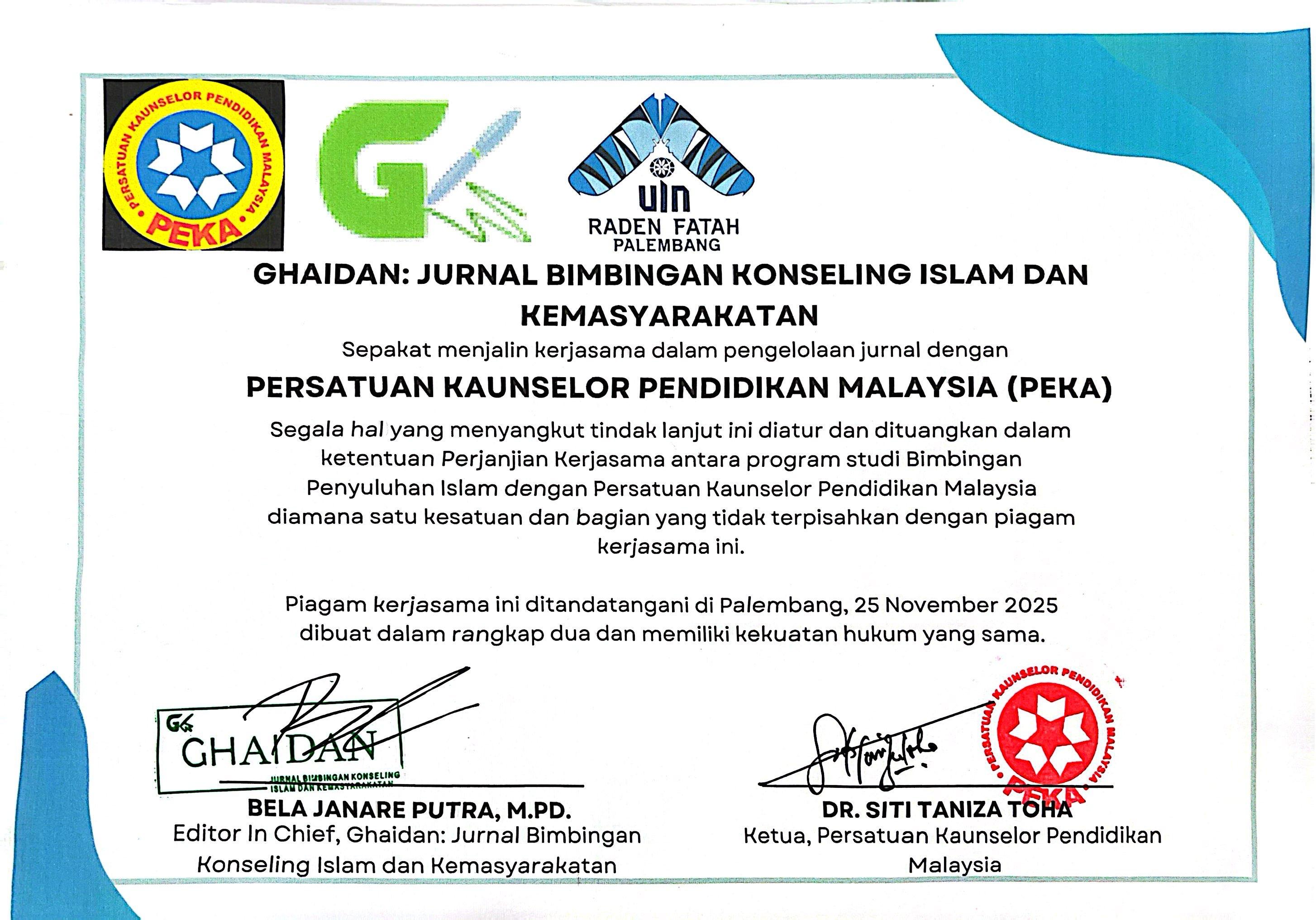Analisis Hubungan Antara Stunting dan Kapasitas Kognitif pada Anak Sekolah Dasar Usia 7-10 Tahun: Pendekatan Survei Analitik Desain Cross-Sectional
DOI:
https://doi.org/10.19109/ghaidan.v7i2.20786Abstract
The study was conducted to analyze the results of stunting of primary school children aged 7-10 years, the results of cognitive capacity of primary school children, and the relationship between stunting and children's cognitive capacity. The method used was analytical survey research with a cross-sectional approach design. The measuring instrument used was an intelligence test (IQ), namely CPM (Colored Progressive Matrics) interpreted by RAVEN, which was used to find the results of cognitive capacity and Weight Scales and Stature meters (measuring children's height). Sampling was determined through Anthropometric criteria of Child Nutritional Status Assessment with IMT/U index in the 5-18 years category through Waterlow criteria (< 95%). Data analysis techniques were used with Fisher's Exact Test, and the study's results found no significant relationship between stunting and cognitive capacity.
References
Arfines, P. P., & Puspitasari, F. D. (2017). Hubungan Stunting dengan Prestasi Belajar Anak Sekolah Dasar di Daerah Kumuh, Kotamadya Jakarta Pusat. Buletin Penelitian Kesehatan, 45(1), 45–52. https://doi.org/10.22435/bpk.v45i1.5798.45-52
Beal, T., Tumilowicz, A., Sutrisna, A., Izwardy, D., & Neufeld, L. M. (2018). A review of child stunting determinants in Indonesia. Matern Child Nutr, 14(4), e12617. https://doi.org/10.1111/mcn.12617
Bujuri, D. A. (2018). Analisis Perkembangan Kognitif Anak Usia Dasar dan Implikasinya dalam Kegiatan Belajar Mengajar. LITERASI (Jurnal Ilmu Pendidikan), 9(1), 37. https://doi.org/10.21927/literasi.2018.9(1).37-50
Daracantika, A., Ainin, A., & Besral, B. (2021). Pengaruh Negatif Stunting terhadap Perkembangan Kognitif Anak. Jurnal Biostatistik, Kependudukan, Dan Informatika Kesehatan, 1(2), 113. https://doi.org/10.51181/bikfokes.v1i2.4647
Duijff, S. N., Klaassen, P. W., de Veye, H. F., Beemer, F. A., Sinnema, G., & Vorstman, J. A. (2012). Cognitive development in children with 22q11.2 deletion syndrome. Br J Psychiatry, 200(6), 462-468. https://doi.org/10.1192/bjp.bp.111.097139
Ekholuenetale, M., Barrow, A., Ekholuenetale, C. E., & Tudeme, G. (2020). Impact of stunting on early childhood cognitive development in Benin: evidence from Demographic and Health Survey. Egyptian Pediatric Association Gazette, 68(1). https://doi.org/10.1186/s43054-020-00043-x
Ginting, K. P., & Pandiangan, A. (2019). Tingkat Kecerdasan Intelegensi Anak Stunting. Jurnal Penelitian Perawat Profesional, 1(1), 47–52. https://doi.org/10.37287/jppp.v1i1.25
Gunawan, G., Manoppo, J. I. C., & Wilar, R. (2018). Hubungan Stunting dengan Prestasi Belajar Anak Sekolah Dasar di Kecamatan Tikala Manado. E-CliniC, 6(2), 147–152. https://doi.org/10.35790/ecl.6.2.2018.22128
Idwan, I. W., & Sartiah Yusran, F. N. (2018). Hubungan Status Stunting dan Prestasi Belajar Pada Siswa-Siswi Kelas 4, 5, dan 6 di SD Negeri 1 Mawasangka Kecamatan Mawasangka Kabupaten Buton Tengah Tahun 2017. Jurnal Ilmiah Mahasiswa Kesehatan Masyarakat, 3(2), 1–9.
Kaushik. (2009). No Title一位學齡前期急性支氣管炎病童之護理經驗. 源遠護理, 2(1), 1–8.
Kuddus, M. A., McBryde, E. S., & Adegboye, O. A. (2019). Delay effect and burden of weather-related tuberculosis cases in Rajshahi province, Bangladesh, 2007-2012. Sci Rep, 9(1), 12720. https://doi.org/10.1038/s41598-019-49135-8
Nirmalasari, N. O. (2020). Stunting Pada Anak : Penyebab dan Faktor Risiko Stunting di Indonesia. Qawwam: Journal For Gender Mainstreming, 14(1), 19–28. https://doi.org/10.20414/Qawwam.v14i1.2372
Nur, A. A. W., Mokhtar, S., Nurmadilla, N., Bamahry, A. B., & Jafar, M. A. (2023). Hubungan Antara Status Gizi Dengan Prestasi Belajar Anak Pada Usia 9 - 12 Tahun. Wal'afiat Hospital Journal, 4(1), 23–30. https://doi.org/10.33096/whj.v4i1.99
Nurdin, A., Isa Tibrahim, M., & Fuadi, Z. the Relationship Between Stunting and Student Learning Achievement in Elementary School/Ministry in the Working Area of Ligan Puskesmas, Aceh Jaya District. International Journal of Educational Review, 144–157.
Oot, L., Sethuraman, K., Ross, J., & Diets, A. E. S. (2016). Effect of Chronic Malnutrition ( Stunting ) on Learning Ability , a Measure of Human Capital : A Model in PROFILES for Country-Level Advocacy. In Technical Brief, Food and Nutrition Technical Assistance III Project (Vol. February, pp. 1–8). https://www.fantaproject.org/sites/default/files/resources/PROFILES-brief-stunting-learning-Feb2016.pdf
Picauly, I., & Toy, S. M. (2013). Analisis Determinan Dan Pengaruh Stunting Terhadap Prestasi Belajar Anak Sekolah Di Kupang Dan Sumba Timur, Ntt. Jurnal Gizi Dan Pangan, 8(1), 55. https://doi.org/10.25182/jgp.2013.8.1.55-62
Pratiwi, R., Sari, R. S., & Ratnasari, F. (2021). Dampak Status Gizi Pendek (Stunting) terhadap Prestasi Belajar. Jurnal Ilmiah Ilmu Keperawatan, 12(2), 10–23. https://doi.org/https://stikes-nhm.e-journal.id/NU/article/view/317/284
Puspitasari, D. A., Kustiyah, L., Dwiriani, C. M., & Widodo, Y. (2021). Pengaruh Karakteristik Keluarga Dan Status Gizi Anak Dengan Perkembangan Kognitif Anak Usia Prasekolah Di Kota Bogor. Penelitian Gizi Dan Makanan (The Journal of Nutrition and Food Research, 44(2), 105–113. https://doi.org/10.22435/pgm.v44i2.5520
Rahmidini, A. (2020). Hubungan stunting dengan perkembangan motorik dan kognitif anak. Seminar Nasional Kesehatan, 2(1), 90–104. https://doi.org/http://www.ejurnal.stikesrespati-tsm.ac.id/index.php/semnas/article/download/272/192
Ramli, Agho, K. E., Inder, K. J., Bowe, S. J., Jacobs, J., & Dibley, M. J. (2009). Prevalence and risk factors for stunting and severe stunting among under-fives in North Maluku province of Indonesia. BMC Pediatr, 9, 64. https://doi.org/10.1186/1471-2431-9-64
Seyoum, D., Tsegaye, R., & Tesfaye, A. (2019). Under nutrition as a predictor of poor academic performance; the case of Nekemte primary schools students, Western Ethiopia. BMC Res Notes, 12(1), 727. https://doi.org/10.1186/s13104-019-4771-5
Suhud, R. F., Fadlyana, E., Setiawati, E. P., Aminah, S., & Tarigan, R. (2021). Hubungan Stunting dengan Gangguan Kognitif pada Usia Remaja Awal di Kecamatan Jatinangor. Sari Pediatri, 23(2), 115. https://doi.org/10.14238/sp23.2.2021.115-20
Sumartini, E. (2020). Studi Literatur : Dampak Stunting Terhadap Kemampuan Kognitif Anak. Prosiding Seminar Nasional Kesehatan "Peran Tenaga Kesehatan Dalam Menurunkan Kejadian Stunting" Tahun, 127–134.
Widanti, Y. A. (2017). Prevalensi, Faktor Risiko, dan Dampak Stunting pada Anak Usia Sekolah. Jurnal Teknologi Dan Industri Pangan, 1(1), 23–28.
Yadika, A. D. N., Berawi, K. N., & Nasution, S. H. (2019). Pengaruh stunting terhadap perkembangan kognitif dan prestasi belajar. Jurnal Majority, 8(2), 273–282.
Yunitasari, L. (2012). PERBEDAAN INTELLIGENCE QUOTIENT (IQ) ANTARA ANAK STUNTING DAN TIDAK STUNTING UMUR 7-12 TAHUN DI SEKOLAHDASAR (Studi pada siswa SD Negeri Buara 04 Kecamatan Ketanggungan Kabupaten Brebes. Jurnal Kesehatan Masyarakat, 1(2), 586–595. https://doi.org/http://ejournals1.undip.ac.id/index.php/jkm





